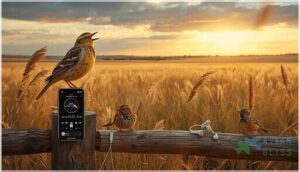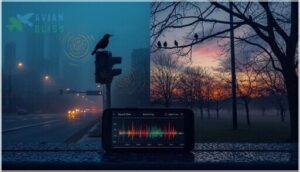This site is supported by our readers. We may earn a commission, at no cost to you, if you purchase through links.
A Wood Thrush sings its flute-like melody deep in the forest canopy. A Red-winged Blackbird rattles from a cattail marsh. An Eastern Meadowlark calls across open prairie grass. Each bird doesn’t just announce its presence—it reveals the exact habitat surrounding it!
The acoustic fingerprint of every environment shapes how birds vocalize, from frequency ranges optimized for dense understory to temporal patterns aligned with resource availability. Forest species produce continuous, tonal sequences that navigate thick vegetation, while grassland birds emit rapid, frequency-modulated chirps designed for open air transmission.
You can decode these patterns and pinpoint ecosystems with striking precision. Modern tools like BirdNET and portable recorders transform casual listening into powerful ecological monitoring, connecting your ears to conservation science happening worldwide.
Table Of Contents
- Key Takeaways
- How Bird Sounds Reveal Habitats
- Distinct Bird Sound Patterns by Habitat
- Techniques for Identifying Habitats by Sound
- Using Technology for Sound-Based Habitat ID
- Tips for Mastering Habitat Identification by Sound
- Frequently Asked Questions (FAQs)
- How do you find out what bird it is by sound?
- Is there a free app to identify birds by sound?
- Can Google detect bird sounds?
- Is there a Shazam for bird sounds?
- How do you identify seabirds in a coastal habitat?
- How do you know if a bird song is loud?
- How do you identify birds?
- What is birding by habitat?
- How can I tell what kind of bird it is by its sound?
- Is there an app to identify birds by sound?
- Conclusion
Key Takeaways
- Bird vocalizations function as acoustic fingerprints that reveal specific habitat types—forest species produce continuous tonal sequences optimized for dense vegetation, while grassland birds emit rapid frequency-modulated chirps designed for open-air transmission across prairies and savannas.
- AI-powered tools like BirdNET and Merlin Bird ID have democratized habitat identification by sound, using neural networks to analyze recordings with over 95% accuracy in controlled conditions and enabling instant species recognition that connects acoustic patterns directly to ecosystem types.
- Each habitat creates distinct soundscapes shaped by environmental acoustics—wetlands feature low-frequency resonant calls that travel over water, urban environments force birds to sing earlier and at higher frequencies to cut through traffic noise, and forests showcase vertical stratification through canopy-dwelling species delivering high-pitched dawn trills.
- Mastering sound-based habitat identification requires systematic practice with labeled field recordings, documentation of metadata including location and weather conditions, and validation against expert-confirmed identifications to transform casual listening into precise ecological monitoring that advances conservation science.
How Bird Sounds Reveal Habitats
Bird songs aren’t just beautiful—they’re revealing clues about where those birds live! Each habitat shapes the vocalizations you’ll hear, from the tonal sequences echoing through dense forests to the rapid chirps across open grasslands.
Let’s explore how bird calls connect directly to their environments and what acoustic clues tell you about the world around them.
The Relationship Between Bird Calls and Environment
Bird calls aren’t random noise—they’re acoustic fingerprints of habitat structure! You’ll hear species endemic to forests, wetlands, or grasslands using frequency ranges optimized for their environment’s vegetation density and understory complexity.
Bird calls are acoustic fingerprints revealing whether a species lives in forests, wetlands, or grasslands
Calling patterns shift with wind, rainfall, and background biophony, while temporal rhythms align with resource availability. This is acoustic ecology in action, revealing species interactions through bird communication and environmental acoustics that make habitat acoustics, bioacoustics, and ecological monitoring through bird songs and acoustic monitoring possible! Tools like BirdNET for automated bird sound identification help researchers decode these acoustic patterns and track species behavior across changing landscapes.
Researchers can utilize scientific study audits to improve their understanding of ecological systems.
Key Habitat Types Identified by Sound
You’ll encounter five distinct soundscapes where Sound ID and BirdNET excel at Bird Identification through Audio Monitoring: These tools also help researchers monitor stress indicators in captive environments, where proper feather health maintenance supports overall bird welfare during acoustic studies.
- Forests and woodlands – continuous, tonal Bird Songs
- Grasslands and savannas – rapid, repetitious Bird Calls
- Freshwater wetlands and marshes – splashy, peeping vocalizations
- Marine coastal and estuarine zones – salt-adapted species
- Urban green spaces and suburban edges – mixed assemblages
Acoustic Monitoring transforms Habitat Acoustics into Ecosystem Analysis, enabling Sound Mapping across every environment you explore! Modern bird call identification devices bring this technology to your fingertips, using real-time acoustic recognition to reveal hidden species in forests, wetlands, and urban parks alike.
Acoustic Indicators of Specific Bird Habitats
When you listen closely, Habitat Acoustics reveal each ecosystem’s story! Acoustic Analysis highlights vertical stratification through minimum frequency and bandwidth, as demonstrated by canopy-dwelling passerines delivering high-pitched trills at dawn.
Grassland Bird Soundscapes feature frequency-modulated chirps adapted to open air, while wetland residents produce resonant, buzzy notes that propagate over water.
BirdNET and AI-Powered Sound Identification transform these patterns into Ecological Monitoring, enabling precise Species Detection and Biodiversity Analysis through Acoustic Biodiversity Monitoring and Bioacoustics!
Distinct Bird Sound Patterns by Habitat
Each habitat has its own acoustic fingerprint! Forest birds favor continuous, tonal sequences that carry through dense vegetation, while grassland species rely on rapid chirps that maintain flock cohesion across open terrain.
Wetlands, prairies, forests, and even urban environments each shape the calls, songs, and timing patterns you’ll hear when you step outside and listen.
Forest Bird Songs and Calls
When you step into a forest, you’re walking into one of nature’s richest sonic landscapes! Woodland species broadcast habitat secrets through their bird call patterns. Listen for:
- Woodpecker drumming signaling standing dead trees and moist coniferous zones
- High-frequency understorey trills marking dense leaf litter layers
- Warbler canopy songs revealing mixed deciduous-coniferous stands
- Repetitive contact calls indicating continuous forest blocks
BirdNET and Sound ID help decode these forest acoustics, turning bird songs into powerful bird identification techniques for understanding bioacoustics and habitat structure!
Grassland and Prairie Bird Vocalizations
Open spaces sing a different tune! Grassland song patterns feature rapid, repetitious chirps and buzzy trills that travel across windswept prairies. You’ll catch Western Meadowlarks delivering flute-like melodies, Grasshopper Sparrows producing insect-like trills, and Bobolinks bubbling metallic sequences.
Sound ID and BirdNET excel at decoding these prairie bird calls, transforming acoustic monitoring into powerful habitat audio analysis that reveals open-country biodiversity!
Wetland and Water Bird Sounds
Marshes pulse with sonic diversity! Wetland acoustics showcase low-frequency, resonant notes from herons and bitterns—those haunting “pump-er-lunk” calls travel effortlessly over water. You’ll detect rattling alarm calls from grebes, squeals from dabbling ducks, and soft piping from mudflat waders.
BirdNET and AI-powered sound identification excel at bioacoustics analysis, decoding these aquatic species through sophisticated species identification that captures waterbird calls within complex bird soundscapes!
Urban and Suburban Bird Soundscapes
Cities reshape bird soundscapes through sonic pollution and acoustic fragmentation. Urban noise forces blackbirds and great tits to sing up to 5 hours earlier, dodging traffic roar. BirdNET and AI-powered sound identification decode these temporal shifts through acoustic monitoring and bioacoustics analysis.
Your suburban ecology reveals:
- Earlier dawn songs in high-noise zones
- Frequency shifts upward to cut masking
- Exotic species dominating urban cores
- Simplified assemblages versus rural diversity
- Bird migration timing altering seasonal soundscapes
Species identification adapts as cities reshape vocal behavior! This phenomenon is closely related to light pollution effects.
Techniques for Identifying Habitats by Sound
You can’t identify a habitat by sound unless you know what to listen for. The trick is training your ear to catch signature calls, compare vocal patterns across different landscapes, and recognize when multiple species are singing together.
Let’s break down three core techniques that will sharpen your acoustic identification skills in the field.
Listening for Signature Vocalizations
Flight calls and alarm notes cut through the dawn chorus like acoustic fingerprints! You’ll recognize habitat types by listening for species-specific frequencies and timing patterns that reveal roosting environments.
BirdNET and AI-powered sound identification tools decode these acoustic cues using neural networks, while bioacoustics research shows how bird calls enhance propagation in grasslands versus forests.
Recording context—time, weather, location—ensures accurate species identification from vocalization patterns.
Comparing Songs Across Habitats
You’ll notice forest habitats host higher-pitched trills that slice through dense foliage, while grassland bird songs travel slower with pitched emphasis across open distances. BirdNET and AI-powered sound identification tools analyze these habitat acoustics using neural network bioacoustics, revealing how vocalization types adapt to ecosystem sonics.
Wetlands favor resonant frequencies over water, and urban soundscapes push birdcall patterns toward increased repetition amid city noise.
Recognizing Mixed-Species Soundscapes
When two or more species vocalize at once, acoustic overlap masks individual calls—that’s where BirdNET and AI-powered sound identification shine! Neural networks trained through bioacoustics research parse these complex soundscapes analysis challenges, revealing species interactions and vocalization patterns your ear might miss.
Your birding app becomes a bioacoustic monitoring powerhouse, detecting temporal layering that defines habitat richness and breeding activity across diverse assemblages.
Using Technology for Sound-Based Habitat ID
Technology has revolutionized how we identify birds and their habitats by sound! You don’t need years of field experience when AI-powered apps and recording tools can analyze vocalizations in seconds, connecting acoustic patterns to specific environments.
Let’s explore the essential tools that bring sound-based habitat identification within your reach—from smartphone apps to citizen science platforms that utilize community data.
AI-Powered Bird Sound Identification Apps
BirdNET and similar AI-powered sound identification apps use neural networks to deliver instant species recognition! Machine learning algorithms analyze audio recordings and compare them against thousands of labeled calls, achieving accuracy exceeding 95% in controlled datasets.
BirdNET-Analyzer processes your field recordings with confidence scores, helping you decode which species populate forests, wetlands, or grasslands. These tools transform how you connect bird vocalizations to habitat types.
Offline Tools and Recording Devices
Merlin and BirdNET operate completely offline! You don’t need internet to identify species in forests, wetlands, or grasslands. Portable Recorders with quality Field Microphones capture sounds that Sound Analyzers decode later using BirdNET-Analyzer. Acoustic Sensors monitor habitats year-round, building Bird Call Databases for Wildlife Conservation. These Birding Apps and Tools deliver AI-Powered Sound Identification wherever your adventures lead!
- Works without internet connectivity anywhere
- Captures high-quality audio for later analysis
- Processes recordings with confidence scores instantly
- Monitors remote locations continuously for research
- Builds personal sound libraries over time
Leveraging Citizen Science Platforms
eBird and BirdNET connect you with thousands of citizen scientists worldwide, transforming your recordings into Wildlife Conservation Efforts! Platforms use Data Validation and expert reviews to guarantee quality.
Your contributions support Environmental Education and Awareness while Platform Integration lets researchers compare habitat changes across seasons.
Citizen Engagement turns solo birding into Community Outreach—every sound you share advances Sound Analysis for ecosystems everywhere!
Tips for Mastering Habitat Identification by Sound
You’ve explored the tools—now it’s time to sharpen your skills! Mastering habitat identification by sound takes practice, awareness of common mistakes, and staying current with evolving technology.
Here are three essential strategies to accelerate your learning and build confidence in the field.
Practicing With Field Recordings
You can’t truly master habitat identification without putting your ears to the test! Field recording practice sessions sharpen your acoustic training and transform raw audio analysis into reliable bird call recognition. Here’s your roadmap:
- Start with clearly labeled, high-quality recordings before tackling composite soundscapes
- Include metadata—location, date, weather—to contextualize sound patterns
- Create fixed playlists covering multiple habitats and seasons for structured listening
- Pair practice with expert-confirmed identifications using tools like BirdNET and the Bird ID Wizard
- Log misidentifications with corrective notes to boost future accuracy
Regular self-assessment checklists track your progress in ornithology and bird watching adventures!
Avoiding Common Pitfalls
Even seasoned bird watchers stumble when sample size is too small or background noise drowns out target signals. You must document metadata management—location, date, conditions—so your BirdNET data quality stays high and error mitigation becomes routine.
Don’t lean on one species as your habitat proxy; ecological research demands community sound profiles. Noise reduction and AI-powered sound identification tools support species conservation when you validate every call!
Staying Updated With New Sound ID Tools
Regularly scan bioacoustics news feeds and developer announcements to catch Sound ID Updates and App Releases the week they drop.
Follow research trends in peer-reviewed journals for Tool Validation studies that confirm which AI-Powered Sound Identification platforms—like BirdNET and BirdNET-Analyzer—deliver the most accurate Machine Learning Applications.
Subscribe to credible citizen science newsletters so you never miss groundbreaking capabilities!
Frequently Asked Questions (FAQs)
How do you find out what bird it is by sound?
You’d think modern technology makes it easy, but successful Bird Sound Analysis still demands your ear and patience.
Record vocalizations, compare them to Merlin Bird ID or BirdNET libraries, then verify using habitat context and distinctive acoustic patterns.
Is there a free app to identify birds by sound?
Merlin Bird ID and BirdNET offer completely free, AI-powered sound identification! Both mobile apps use extensive audio databases for accurate species recognition, work offline, and support birders worldwide without subscriptions or hidden fees.
Can Google detect bird sounds?
Google’s audio classification models do support bird sound analysis!
Machine learning algorithms power Android and web platforms, enabling you to upload recordings for identification—though effectiveness depends on audio quality and training data breadth.
Is there a Shazam for bird sounds?
BirdNET and similar AI-powered sound identification apps act as your personal field guide.
They use machine learning and audio fingerprinting to match recorded calls against vast libraries—instant species ID in your pocket.
How do you identify seabirds in a coastal habitat?
Listen for sharp alarm calls from terns or raspy gull croaks along rocky shorelines!
BirdNET and eBird help birders confirm coastal habitat species identification through AI-powered sound identification and acoustic monitoring of seabird vocalizations.
How do you know if a bird song is loud?
You gauge bird song loudness through Sound Pressure level meters or Acoustic Analysis software. Loudness Metrics compare peak amplitude across recordings.
Distance, background noise, and habitat density all affect perceived intensity in Bird Vocalization studies.
How do you identify birds?
You identify birds by observing plumage patterns, body morphology, and beak identification features. Vocalizations—including song structure and call notes—offer species-specific cues.
Habitat context, seasonal presence, and migration patterns help narrow possibilities through systematic species classification and ornithology and bird study methods.
What is birding by habitat?
Think of birding by habitat as reading the landscape like sheet music. You identify birds by surveying their environment—forests, wetlands, grasslands—using ecosystem structure, vegetation layers, and species mapping to predict which birds call each habitat home.
How can I tell what kind of bird it is by its sound?
You can narrow down species by analyzing frequency ranges (1–8 kHz), repetition patterns like trill rates, and phrase order. BirdNET and other AI-powered sound identification tools instantly match recordings to species!
Is there an app to identify birds by sound?
Merlin Bird ID and BirdNET are standout mobile apps using AI-powered sound identification to recognize species from recordings! Both work offline, analyze audio clips instantly, and deliver confidence scores you can verify against field observations.
Conclusion
Every forest whisper and marsh rattle becomes a map when you learn the language. You’ve unlocked identifying bird habitats by sound—a skill that transforms walks into scientific expeditions!
Download BirdNET tomorrow morning. Record your backyard chorus. Compare wetland trills against grassland chirps.
Your ears now decode ecosystems with precision ornithologists trust. The soundscape reveals what eyes miss, connecting you directly to conservation efforts protecting these vanishing voices. Start listening differently today!











